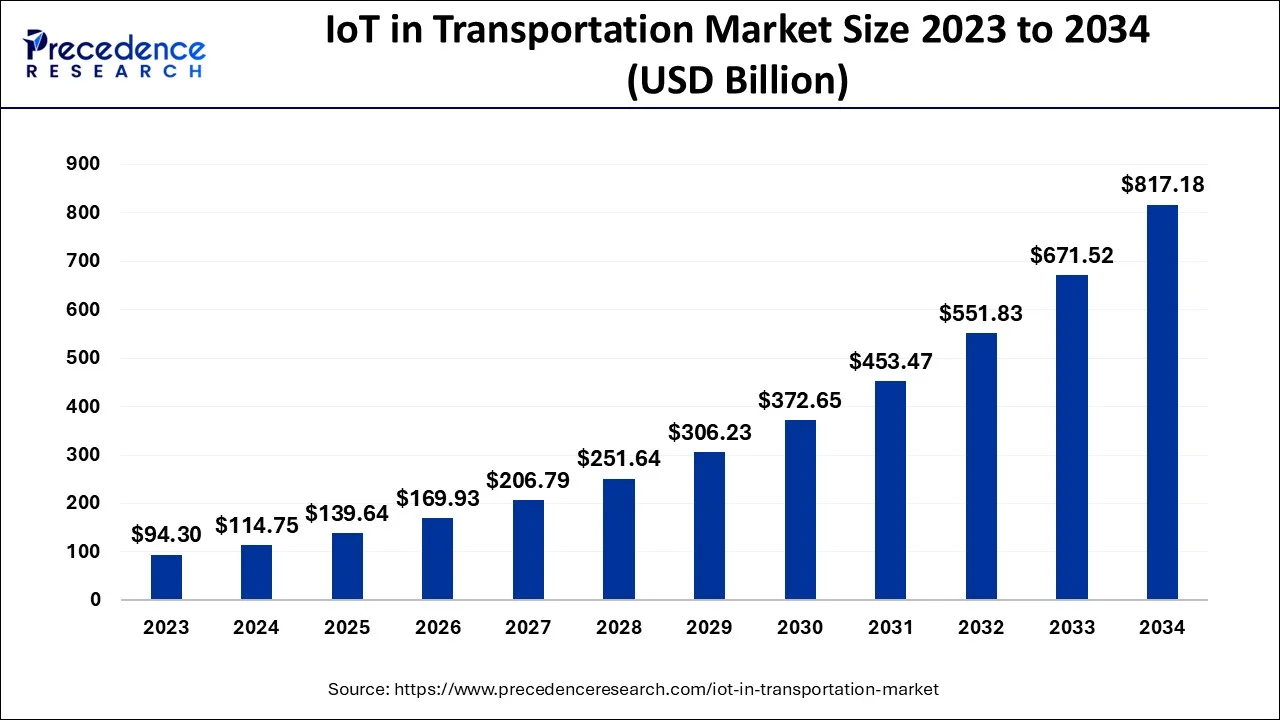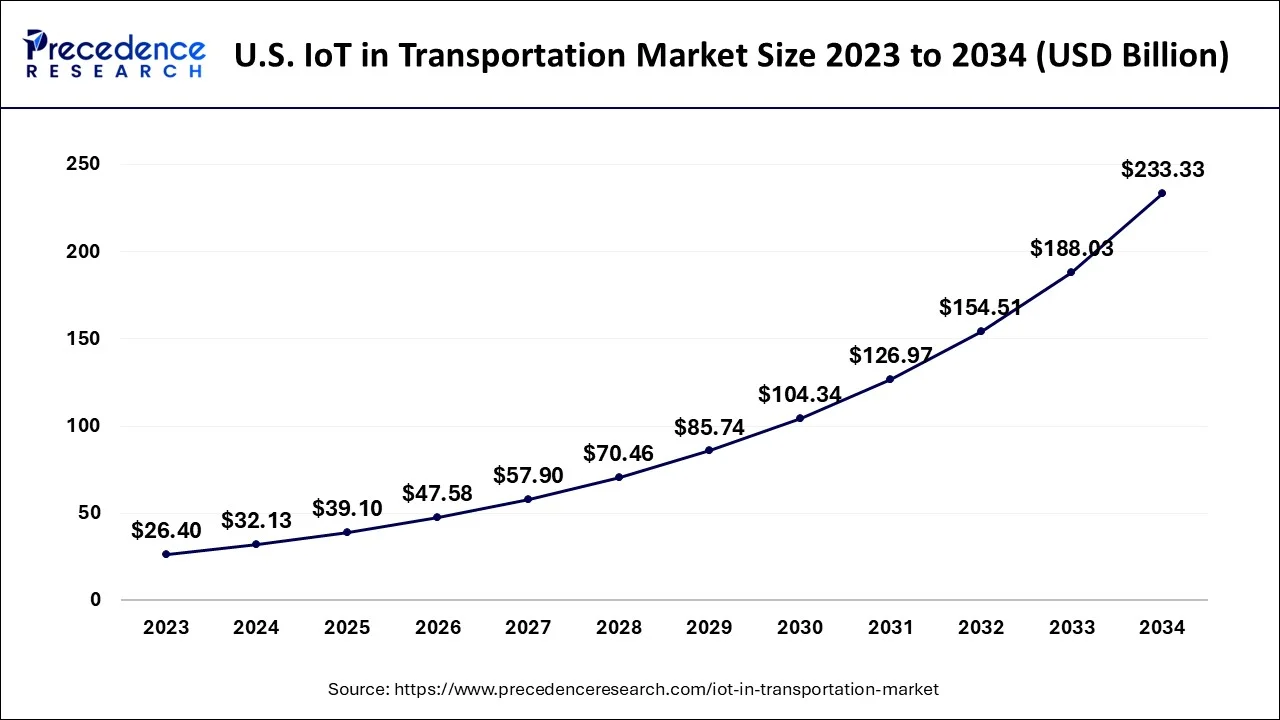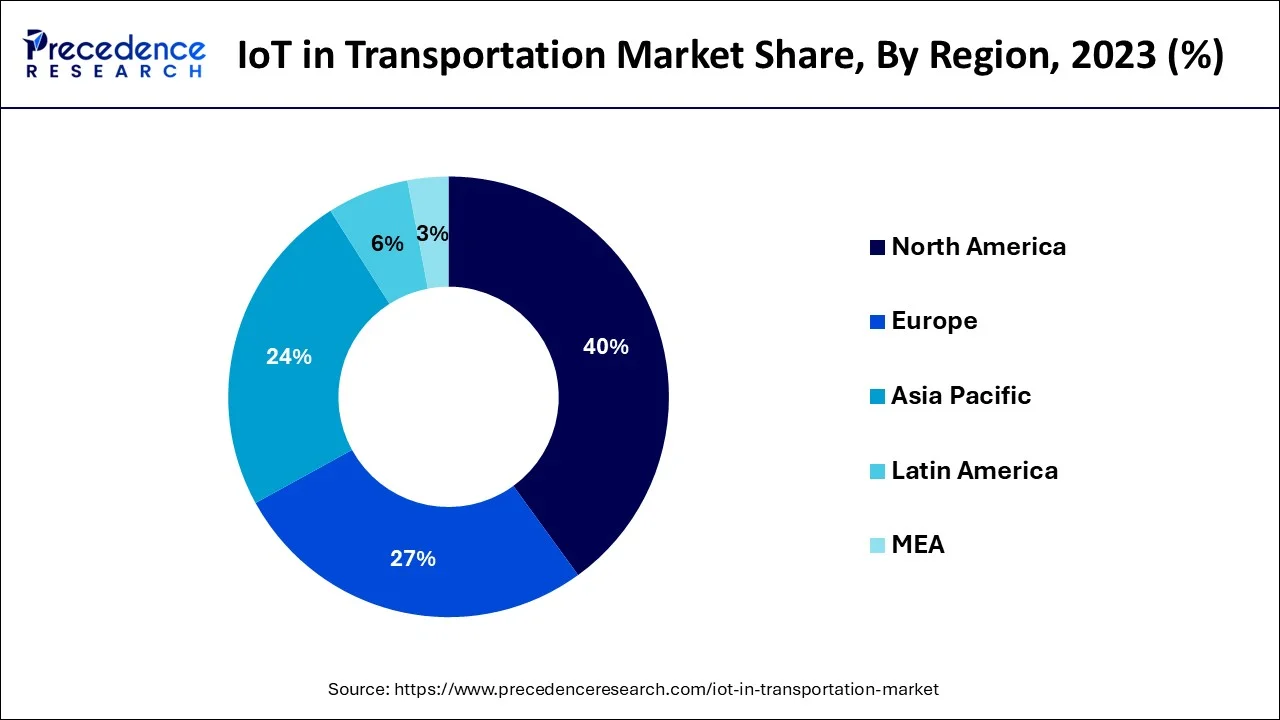List of Contents
What is the IoT in Transportation Market Size?
The global IoT in transportation market size is calculated at USD 139.64 billion in 2025 and is predicted to increase from USD 169.93 billion in 2026 to approximately USD 945.53 billion by 2035, expanding at a CAGR of 21.08% from 2026 to 2035.

IoT in Transportation Market Key Takeaways
- The North America region has garnered a revenue share of over 40% in 2025.
- The Asia-Pacific region is expected to grow at a remarkable CAGR of 21% from 2026 to 2035.
- By mode of transportation, the rail segment is poised to grow at a CAGR of 21.5% between 2026 to 2035.
- By source, the software segment accounted revenue share of over 48% in 2025.
Market Overview
The networking of physical tools and machines is known as the Internet of Things (IoT), and it has applications in the automotive, electronics, insurance, industrial, and retail sectors. It makes use of device connectivity to remotely control or detect objects. Numerous services are offered by it, such as traffic congestion control, security and surveillance systems, toll and ticketing systems, vehicle telematics and reservations, remote monitoring, and others. It can be found, among other places, in smart grids, smart homes, smart cities, and virtual power plants. One of the most crucial platforms for applications like smart energy management systems and smart cities is the Internet of Things (IoT).
IoT technology assist in giving clients more precise, current, and real-time data to help them plan trips and enhance communication. Additionally, using IoT-enabled technology, it gives the potential to measure things like train speeds, aero plane part conditions, roadway temperatures, and the number of vehicles at an intersection, all of which can assist to increase the safety of our transit systems globally. The market for IoT in transportation offers enormous potential, but it also heavily depends on how quickly enterprises adopt new technologies. With such a quick transformation, it would be feasible to provide users, governments, and enterprises with exceptional quality of experience in addition to increased economic potential.
IoT in Transportation Market Growth Factors
In the upcoming years, it is projected that there will be a rise in the need for intelligent traffic control, increased transportation safety thanks to IoT-connected devices, and investments made by industry leaders to diversify their product lines with cutting-edge IoT-driven technology. The main drivers of the growth of the IoT in intelligent transportation systems market over the forecast period are the increased emphasis on R&D to enhance IoT integrated software and lower the cost associated with its operation.
The world's expanding demand for urban connections is causing a considerable development of the railway network, which is producing a positive prognosis for the industry. In the railroad sector, IoT is frequently used to manage timetables, maximize capacity, and carry out preventative maintenance. The The industry is thus able to improve operational effectiveness and safety while decreasing delays. Due to the increasing demand for connected mobility solutions that save commuting times, significant product utilization in highway automobiles is also having a favorable impact on market growth.
Moreover, by maximizing performance while utilizing the least amount of resources, it can increase efficiency. This challenging goal is realizable by integrating IoT into freight strategy. Increasing multimodal visibility is one strategy for cutting back on resources in logistics and transportation.
IoT technology provides drivers with the precise routes to avoid traffic, bad weather, and expensive fuel. Even better, if issues do develop, IoT devices update in real-time, allowing users to take immediate action. IoT also provides correct information prior to shipping and improved visibility while in route to boost productivity. As mentioned, IoT considerably increases intermodal visibility, which is advantageous to both customers and businesspeople. Moreover, investing in IoT gives your customers reliable information about the state of their products, enhancing their whole experience.
IoT offers analytics, monetization, connectivity, security, and security to enable more intelligent transportation tactics. A long-term technology development for transportation and supply networks is the Internet of Things. Businesses will consequently become more adaptable, discover revenues from deeper analysis, offer customers better experiences, and securely deliver items on schedule.
Market Outlook
- Industry Growth Overview: The market is on a strong upward trajectory as governments, businesses, and consumers increasingly adopt smart technologies to manage traffic, optimize logistics, and improve safety.
- Major investors: Major investors and key players in the IoT in Transportation market include tech giants like IBM, Cisco, Microsoft, Intel, Google (Alphabet), Amazon (AWS), Oracle, Qualcomm, etc.
- Global Expansion: The global IoT in transportation market is not only growing; it is undergoing a profound transformation, moving from simple tracking systems to integrated, intelligent ecosystems.
- Startup Ecosystem: This vast ecosystem is characterized by an influx of innovative startups that are leveraging connected devices, sensors, AI, and big data to revolutionize traditional transport and logistics operations.
Report Scope
| Report Coverage | Details |
| Market Size in 2025 |
USD 139.64 Billion |
| Market Size in 2026 |
USD 139.64 Billion |
| Market Size by 2035 |
USD 945.53 Billion |
| Growth Rate from 2026 to 2035 | CAGR of 21.08% |
| Largest Market | North America |
| Base Year | 2025 |
| Forecast Period | 2026 to 2035 |
| Segments Covered | Source, Components, Transport, Application, Geography |
| Regions Covered | North America, Europe, Asia-Pacific, Latin America and Middle East, and Africa |
Segment Insights
Source Insights
Based on source, the hardware segment dominant the IoT in transportation market in 2025. Hardware in the Internet of Things can take many different shapes, from the base processors that run smartphones to the sensors that gather data from the outside world to the edge machines that process and analyze the data. IoT hardware is at the core of any wired project, and as the Internet of Things has grown, so too have the technical capabilities of these boards.
Every aspect of travel, from the schedule to the electronic room key, may be made easier by IoT. In the near future, it might serve as a lone information source. This cause rise in adoption of IoT in the travel industry that rises the IoT market.
The desire for integrated security and safety systems to boost public safety as well as an increase in the usage of linked and smart technology in transportation infrastructure are two factors contributing to the considerable market share represented by the software sector.
Transport Insights
Depending upon the transport, the airways and maritime segment is the dominant player and is anticipated to have the biggest impact on IoT in transportation market. As connected devices and sensor-based systems open the door for numerous forms of regulation and control, the IoT has altered the ways and methods of the industry. In addition to this, baggage monitoring, cabin climate management, and even emergency alerts are other key milestones that are being employed in the aviation industry as it continues to incorporate IoT techniques and devices. These span from passengers to personnel. Although it may seem ludicrous, there is actual air traffic on the runway. For a step further, the planes can be made to be tracked via a system of the times of their arrival and departure so that it is possible to see for the availability and pauses on the runways, even though the planes are already tracked of their real-time location and maintained communication with.
Railways transportation has seen a significant growth in the transportation market. IoT in railways is made possible by a wide variety of smart devices, including temperature and vibration sensors, station and vehicle cameras, digital signs, machine learning libraries, security systems, and more. By combining these intelligent devices into a single end-to-end solution, railroad operators can: transform data into useful insights; and increase the effectiveness of current systems. With the use of sensors, cameras, and in-vehicle computers, rail operators can keep track of diagnostic data for their fleet to prevent breakdowns, anticipate maintenance needs, and plan out servicing plans to keep trains moving and minimizing downtime. Additionally, smart cameras with computer vision and artificial intelligence (AI) capabilities assist in automating safety alerts for hazardous water spills, fires, and accidents. Additionally, they can be used to find lost children in crowded places or to see if someone goes into conveyor belts, trips and tag on escalators or onto trackways, or enters forbidden areas.
Regional Insights
The U.S. IoT in transportation market size is exhibited at USD 39.1 billion in 2025 and is projected to be worth around USD 270.78 billion by 2035, growing at a CAGR of 21.35% from 2026 to 2035.

The highest market share and dominant position in the IoT in transportation market belongs to North America during the forecast period. Due to the region's strong industrial, logistics, and transportation sectors and their numerous technological breakthroughs, the IoT is growing in the transportation business. Additionally, it is anticipated that government initiatives and regulations in a variety of end-user industries will promote market expansion in the area. Additionally, a highly skilled labor and reasonably low costs have benefited both domestic and foreign businesses in the U.S. logistics sector.
U.S. IoT in Transportation Market Trends
In North America, the U.S. dominated the market owing to government push towards safety and emissions, along with the growing need for real-time tracking. Also, robust support for smart infrastructure, emission reduction, and traffic control can impact positive market growth in the country further.

Asia-Pacific is considered as second largest region in IoT in transportation market. This region includes China, India, Japan, South Korea, and rest of the world. One of the markets for IoT transportation in Asia Pacific with the quickest growth rate is the automotive industry. As IoT use increases in the transportation industry, a variety of tools & services have been combined to provide better transport management through a variety of systems. Among others, it consists of a system for controlling traffic congestion, toll and ticketing systems, automobile telematics, reservations, security and surveillance systems, and remote monitoring. The adoption of IoT in the Asia Pacific region's transportation sector makes it easier to improve operation and control, traffic planning, the management of staff and passenger information, material management, energy management, data analytics, and other processes. It provides services for cloud application development, tail allocation, sensory inputs, unforeseen aircraft repair, and reliable & secure communications. Reduced prices for powerful sensors and controllers, increased connectivity, an increase in information, communication, and technology, increased internet penetration, government initiatives for smart cities, and spending by governments in the Asia Pacific region are a few of the key factors propelling the market's growth.
India IoT in Transportation Market Trends
The growth of the market in the country can be attributed to the surge in vehicle ownership, along with the government's push towards smart cities. Moreover, rapid urbanization in the emerging economies fuels demand for smart solutions, which enable rapid data transfer for connected devices, leading to market expansion soon.
Europe is expected to grow at the fastest rate over the forecast period. The growth of the region can be credited to the EU policies emphasizing decreasing congestion, enhancing road safety, and lowering overall emissions. Furthermore, companies in the region use IoT for route optimization, predictive maintenance, and fuel efficiency.
Germany IoT in Transportation Market Trends
In Europe, Germany led the market due to increasing online retail demands, real-time tracking, and convenient supply chain solutions. The country is a major European automotive hub with key companies such as BMW and VW, emphasizing designing and developing smart, connected vehicles, driving market growth shortly.
IoT in Transportation Market-Value Chain Analysis
- Sensors and Devices (Hardware)
This foundational layer involves the manufacturing of physical components that collect data from vehicles, cargo, and infrastructure.
Major Players: Intel Corporation, Qualcomm - Connectivity
It involves communication networks (e.g., cellular 4G/5G, Wi-Fi, LPWAN, satellite) that transmit the collected data between devices and central systems.
Major Players: Verizon Communications Inc., Vodafone. - Software & Platform
This stage includes middleware platforms and cloud infrastructure for data ingestion, processing, storage, analytics, and device management.
Major Players: IBM Corporation, Microsoft. - Services & Applications
It includes end-user applications and services (e.g., fleet management software, predictive maintenance, route optimization, customer portals) that provide actionable insights and solutions.
Major Players: Kapsch TrafficCom, Conduent, Inc.
IoT in Transportation Market Companies
- IBM Corporation: IBM offers robust IoT platforms, such as the IBM Watson IoT Platform, which provide data analytics, cloud computing, and AI integration for managing large volumes of data generated by connected vehicles and infrastructure.
- Cisco Systems, Inc.: As a leader in networking and IT, Cisco provides secure network infrastructure and IoT security solutions, ensuring reliable data transmission and device management across large transportation environments.
Other Major Key Players
- Alcatel-Lucent
- AT&T Inc.
- Garmin International Inc.
- Denso Corp.
- Thales Group
- General Electric
- Verizon Communications Inc.
- TomTom N.V.
Key Market Developments
- Verizon established a partnership with Audi America to provide embedded in-vehicle networking solutions and advanced connectivity. According to reports, the Audi A4 and A5 model lines would be the first to provide these connected vehicle technologies.
Segments covered in the report
By Source
By Components
By Transport
By Application
By Geography
For inquiries regarding discounts, bulk purchases, or customization requests, please contact us at sales@precedenceresearch.com
Frequently Asked Questions
Ask For Sample
No cookie-cutter, only authentic analysis – take the 1st step to become a Precedence Research client
 sales@precedenceresearch.com
sales@precedenceresearch.com
 +1 804 441 9344
+1 804 441 9344



